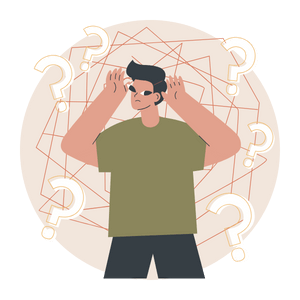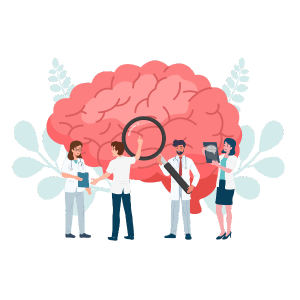In the realm of psychotherapy, understanding distortions in thinking is crucial for effectively addressing clients’ emotional and behavioural challenges. Cognitive distortions, also known as thinking errors or irrational thoughts, refer to biased ways of thinking that can lead individuals to perceive reality inaccurately. These distortions often contribute to negative emotions and maladaptive behaviours, making them a focal point in therapeutic interventions aimed at promoting mental well-being.
Types of Cognitive Distortion

- All-or-Nothing Thinking (Black-and-White Thinking)
- Definition: Viewing situations in extremes, without acknowledging the middle ground or shades of gray.
- Example: A student who receives an A- on an exam sees themselves as a total failure.
- Overgeneralization
- Definition: Drawing broad conclusions based on limited evidence, applying one negative experience to all similar situations.
- Example: After failing one job interview, a person believes they will never be successful in any job interview.
- Mental Filter
- Definition: Focusing exclusively on negative aspects of a situation while ignoring positive aspects.
- Example: A performer receives rave reviews for a show but dwells only on one critical comment.
- Disqualifying the Positive
- Definition: Discounting positive experiences or achievements by insisting they “don’t count” for some reason.
- Example: Despite receiving praise from colleagues, a person believes they only succeeded due to luck.
- Jumping to Conclusions
- Mind Reading: Assuming you know what others are thinking without sufficient evidence.
- Example: Believing a friend is angry with you without asking.
- Fortune Telling: Predicting the future negatively without considering other, more likely outcomes.
- Example: Assuming a project will fail before even starting it.
- Mind Reading: Assuming you know what others are thinking without sufficient evidence.
- Magnification and Minimization (Catastrophizing)
- Magnification: Exaggerating the importance of negative events or qualities.
- Example: Making a small mistake at work and believing it will lead to immediate termination.
- Minimization: Underestimating the significance of positive events or personal strengths.
- Example: Dismissing a promotion as being “no big deal” or “just luck.”
- Magnification: Exaggerating the importance of negative events or qualities.
- Emotional Reasoning
- Definition: Assuming that because you feel a certain way, it must be true.
- Example: Feeling anxious about an upcoming presentation and concluding that it will inevitably go badly.
- Should Statements
- Definition: Using “should,” “ought to,” or “must” statements that impose unrealistic expectations on oneself or others.
- Example: Believing “I should always be perfect” or “Others should always treat me fairly.”
- Labeling and Mislabeling
- Labeling: Applying overly harsh labels to oneself or others based on mistakes or shortcomings.
- Example: Calling oneself a “failure” after making a minor error.
- Mislabeling: Using extreme language to describe an event or behaviour.
- Example: Describing a minor disagreement as a “disaster” or “horrible.”
- Labeling: Applying overly harsh labels to oneself or others based on mistakes or shortcomings.
- Personalization
- Definition: Taking responsibility or blame for events outside of one’s control, assuming they are personally directed.
- Example: Believing a friend’s bad mood is due to something you did, even when there’s no evidence.
Cognitive Distortions and Psychological Disorders
Cognitive and thinking distortions are closely linked to various psychological disorders, exacerbating symptoms and hindering recovery. For instance, individuals with depression often experience pervasive negative thinking patterns, while those with anxiety disorders may catastrophize future events. Understanding these connections helps therapists tailor interventions to address specific distortions underlying clients’ disorders.
Assessment of Cognitive Distortions
Assessing these distortions involves using structured techniques to identify and understand clients’ thinking patterns. Therapists employ several methods, including cognitive assessment interviews, thought records, and collaborative self-monitoring. These tools enable therapists to gain insights into how clients interpret experiences and formulate beliefs that contribute to their emotional distress.
Cognitive Restructuring Techniques

Cognitive restructuring is a cornerstone of therapeutic interventions aimed at correcting cognitive distortions. This process involves guiding clients through steps to challenge and replace irrational thoughts with more balanced, realistic alternatives. Key techniques include:
- Identifying and Challenging Distortions: Encouraging clients to recognize and question their automatic negative thoughts.
- Generating Alternative Thoughts: Helping clients develop alternative interpretations of situations or events.
- Evaluating Evidence: Supporting clients in evaluating evidence for and against their distorted thoughts, fostering a more accurate perspective.
Integrating Cognitive Distortions into Therapy
Integrating the distortions theory into therapy involves utilizing techniques from various therapeutic approaches to effectively address and modify irrational thinking patterns. Here’s how Cognitive Behavioural Therapy (CBT), Mindfulness-based therapies, Narrative Therapy, and Cognitive Hypnotic Psychotherapy (CHP) incorporate principles and techniques to work with cognitive distortions:
Cognitive Behavioural Therapy (CBT)
CBT is renowned for its structured approach to identifying and challenging distorted thoughts. It focuses on the relationship between thoughts, feelings, and behaviours, aiming to replace maladaptive thoughts with more balanced and realistic ones. Key techniques include:
- Cognitive Restructuring: Clients learn to identify automatic negative thoughts, challenge their validity, and replace them with more accurate and adaptive thoughts.
- Behavioural Experiments: Testing the validity of distorted beliefs through behavioural experiments and gathering evidence to support more balanced thinking.
- Homework Assignments: Practicing new cognitive and behavioural skills outside therapy sessions to reinforce learning and promote lasting change.
Mindfulness-based Therapies
Mindfulness-based therapies, such as Mindfulness-Based Cognitive Therapy (MBCT) and Acceptance and Commitment Therapy (ACT), integrate mindfulness practices with cognitive restructuring techniques to enhance awareness and acceptance of cognitive distortions. Techniques include:
- Mindfulness Meditation: Cultivating present-moment awareness to observe thoughts without judgment, thereby reducing automatic reactivity to distorted thinking.
- Cognitive Defusion: Using mindfulness to create distance from thoughts, allowing clients to observe and reinterpret them more objectively.
- Values Clarification: Helping clients identify their core values to guide behavioural changes aligned with their values rather than distorted thoughts.
Narrative Therapy
Narrative Therapy focuses on deconstructing and rewriting personal narratives influenced by cognitive distortions. It helps clients externalize problems, view them as separate from their identity, and construct alternative narratives. Techniques include:
- Externalization: Separating the client from their problems to facilitate objectivity and empower them to challenge distorted narratives.
- Re-authoring: Collaboratively creating new, more empowering narratives that align with the client’s values and goals.
- Unique Outcomes: Identifying exceptions to the problem-saturated story to highlight strengths and resources that challenge the distortions.
Cognitive Hypnotic Psychotherapy (CHP)

CHP integrates principles and techniques from CBT, mindfulness-based therapies, and narrative therapy, enhancing its effectiveness in addressing cognitive distortions. Here’s how CHP incorporates these approaches and specific techniques therapists can use:
- CBT Integration in CHP
- Cognitive Restructuring: Using hypnosis to deepen clients’ engagement in identifying and challenging distorted thoughts.
- Behavioural Experiments: Hypnotically rehearsing new behaviours and responses to test and reinforce cognitive restructuring outcomes.
- Mindfulness Integration in CHP
- Mindful Hypnosis: Using hypnotic techniques to induce a state of mindful awareness, allowing clients to observe and detach from cognitive distortions more effectively.
- Mindful Acceptance: Encouraging clients to accept and acknowledge the distortions without judgment, facilitating a non-reactive stance towards them.
- Narrative Therapy Integration in CHP
- Metaphorical Exploration: Using metaphors and storytelling during hypnosis to externalize the distortions and explore alternative narratives.
- Re-authoring Scripts: Co-creating hypnotic scripts that challenge and reframe distorted narratives, promoting cognitive flexibility and resilience.
Techniques from CHP to Address Cognitive Distortions
- Hypnotic Regression: Guiding clients to revisit past experiences under hypnosis to uncover root causes of distortions and reframe them.
- Metaphorical Imagery: Using metaphorical stories and imagery during hypnosis to illustrate the impact of distorted patterns of thinking and explore alternative perspectives.
- Symbolic Dissociation: Creating dissociative states during hypnosis to help clients observe and separate from distortions, fostering objectivity and insight.
- Suggestion and Affirmation: Using hypnotic suggestions to reinforce adaptive thoughts and affirmations that counteract distortions.
- Integration of Parts: Utilizing hypnosis to integrate conflicting parts of the self that contribute to distorted thinking, promoting inner harmony and coherence.
Conclusion: Embrace Advanced Learning with CHP
By integrating these principles and techniques from CBT, mindfulness-based therapies, and narrative therapy into Cognitive Hypnotic Psychotherapy, therapists can provide a holistic approach to identifying, exploring, and addressing cognitive distortions. This integrative approach enhances therapeutic outcomes by promoting deeper insights, behavioural changes, and emotional resilience in clients.
This comprehensive integration not only enriches therapists’ toolkits but also enhances their ability to tailor interventions to meet the unique needs of each client, fostering lasting positive change in their cognitive and emotional well-being.

